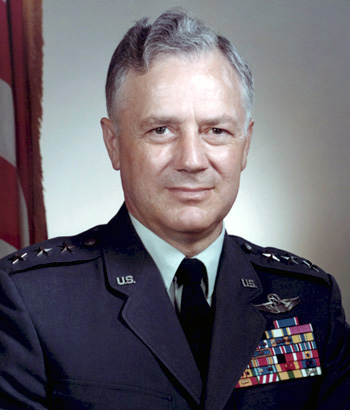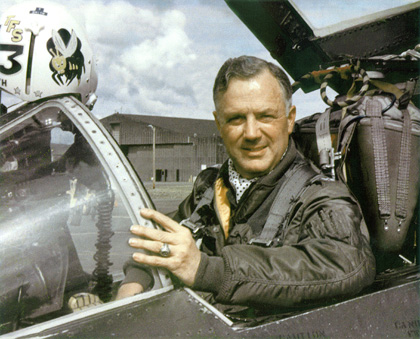
|
Donavon F. Smith |
 |
|||
| Rank, Service | ||||
Lieutenant General O-9, U.S. Air Force |
||||
| Veteran of: | ||||
|
||||
| Tribute: | ||||
Don Smith was born on October 2, 1922, in Dowagiac, Michigan. He enlisted in the Aviation Cadet Program of the U.S. Army Air Forces on January 23, 1942, and was commissioned a 2d Lt and awarded his pilot wings at Victoria Field, Texas, on October 9, 1942. After completing P-47 Thunderbolt training, Lt Smith joined the 61st Fighter Squadron of the 56th Fighter Group at Bridgeport, Connecticut, in November 1942, and deployed with the group to England in January 1943. Maj Smith served as commander of the 61st Fighter Squadron from September 1944 to January 1945. During World War II he was credited with the destruction of 5.5 enemy aircraft in aerial combat plus 1 probable, 2 damaged, and 2 destroyed on the ground while strafing enemy airfields. Maj Smith returned to the U.S. in January 1945 and then served as a project officer in the Tactical Division with the Army Air Force Board at Orlando Army Air Field, Florida, from March to November 1945, followed by service with Headquarters Army Air Forces at the Pentagon from November 1945 to April 1946. He was commander of the 61st Fighter Squadron of the 56th Fighter Group at Selfridge AFB, Michigan, from April 1946 to May 1947, and then served on the staff of the 56th Fighter Group until July 1949. His next assignment was as an exchange officer with the Royal Air Force in England from September 1949 to September 1950, followed by service on the staff and then as commander of the 63rd Fighter Interceptor Squadron of the 56th Fighter Interceptor Group at Selfridge AFB and Oscoda AFB, Michigan, from October 1950 to April 1952. Col Smith was commander of the 76th Air Base Squadron at Niagara Falls AFB, New York, from April 1952 to February 1953, and then Air Commander of the 518th Air Defense Group at Niagara Falls from February 1953 to June 1954. He next served on the staff of Headquarters Air Defense Command at Ent AFB, Colorado, from July 1954 to July 1956, followed by service as commander of the 21st Fighter Bomber Group at Chambley, France, from July 1956 to December 1957. Col Smith served as chief of the Atomic Operations Section on the staff of the Supreme Allied Powers Europe in Paris, France, from December 1957 to July 1960, and then served as Director of NORAD Operations for the 25th NORAD Region at McChord AFB, Washington, from July to December 1960. He was commander of the 325th Fighter Wing at McChord from December 1960 to August 1962, and then attended the National War College at Fort McNair, Washington, D.C., from August 1962 to June 1963. His next assignment was to Headquarters U.S. Air Force in the Pentagon from July 1963 to October 1966, followed by service as Chief of the Air Force Advisory Group to the Military Assistance Command in the Republic of Vietnam from October 1966 to May 1968. Gen Smith next served as Vice Commander of 9th Air Force at Shaw AFB, South Carolina, from April 1968 to August 1969, followed by service as Commander of 19th Air Force at Seymour Johnson AFB, North Carolina, from August 1969 to February 1970. He then returned to Headquarters U.S. Air Force in the Pentagon, where he served from February 1970 to July 1972. Gen Smith's next assignment was as commander of Alaskan Air Command at Elmendorf AFB, Alaska, from August 1972 to June 1973, followed by service as commander of 6th Allied Tactical Air Force at Izmir, Turkey, from June 1973 until his retirement from the Air Force on November 1, 1973. Don Smith died on September 10, 1974, and was buried at the U.S. Air Force Academy Cemetery in Colorado Springs, Colorado. |
||||
|
||||


